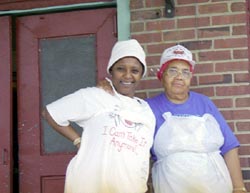Crabs Still True Blue at Crisfield Feast
— For Now
By M.L. Faunce
Crabs, clams and corn topped the menu in Crisfield for the annual J . Millard Tawes Crab and Clam Bake, just as they have for nearly a quarter century. Conceived by the local chamber of commerce to honor their favorite son governor, the midsummer event is usually defined by the political poobahs who show up to see and be seen. But in this off-election year, steaming crabs and dripping net bags of clams, fried sweet potatoes and onion rings ruled in this crabbiest of Eastern Shore towns. . Millard Tawes Crab and Clam Bake, just as they have for nearly a quarter century. Conceived by the local chamber of commerce to honor their favorite son governor, the midsummer event is usually defined by the political poobahs who show up to see and be seen. But in this off-election year, steaming crabs and dripping net bags of clams, fried sweet potatoes and onion rings ruled in this crabbiest of Eastern Shore towns.
Like taking coals to Newcastle, the J. M. Clayton Company of Cambridge, farther up the Shore on the Choptank River, sent crabs to crabtown. The premier Crisfield event has grown so large that crabs come from other Maryland locations, and the clams were brought in from out of state. Some wonder how long the crabs will come from Maryland.
Meanwhile, Back at the Picking House
While party-goers in Crisfield were cracking crabs and hoisting light beer in mason jar mugs at the Tawes 'Bake,' Del. Dick D'Amato detoured first to Cambridge to take a peak at Maryland's largest crab packing house. D'Amato got a little crabby himself during the last General Assembly when fighting for his bill to label crabmeat so consumers can tell the difference between true blue Maryland crabmeat and foreign crabmeat that's not even the same species as those from mid-Atlantic waters.
The J.M. Clayton plant on Cambridge Creek has been picking and packing the real thing - Maryland crab - since 1890. The founder's great grandsons - Jack, Bill and John Brooks - meld their considerable talents to run the business today. Jack is actively lobbying for Maryland crabmeat as competition from cheaper imports drives prices down and pushes Maryland crabbers and processors out of business.
Foreign crabmeat now accounts for two of every three pounds of crabmeat sold in the U.S., according to recent testimony by the domestic blue crab industry. The U.S. industry is seeking relief from the burgeoning foreign threat by requesting tariffs or quotas on imported crabmeat. The day before Crisfield received crab-hungry fairgoers and politicians, the International Trade Commission recommended against either measure. Without this help, many in Maryland's crab industry say they will be forced out of business.
The mood inside the brightly-lit packing room at the J.M. Clayton Company belies troubles in the domestic industry. Forty-five pickers (99 percent of them women) sit in a clinically clean environment at long metal tables. Their soft conversations can be overheard: No banging of wooden mallets here, just the deft movements of ungloved hands snapping crab shells. Using a razor-sharp knife, they slice the edge of the body all around, lift the meat and drop it into contai ners - lump into one, 'special' or flake into another. On and on it goes. Two large banners fixed to opposite walls read "Quality" and "Shell Free." Maybe they are motivational messages. Maybe they're a source of pride. ners - lump into one, 'special' or flake into another. On and on it goes. Two large banners fixed to opposite walls read "Quality" and "Shell Free." Maybe they are motivational messages. Maybe they're a source of pride.
How many crabs can a pro pick? How does 25 to 30 pounds a day sound? At about 100 crabs to a bushel, that's 600 to 800 crabs a day. Easy picking when you know how.
Once filled, containers of crabmeat, fresh and pasteurized, are sent swiftly to the packing room. There, Leona Travers and Shelley Neil work "on-line" together and weigh in with their talent. They are the "final word" they say, "checking for bone," or rather making sure there isn't any, before it's sent out to you, the consumer. They're good at their job, all smiles at the finished product, for they know that each picker's number is on the bottom of containers and will identify the culprit, who'll hear about it, if the meat is less than "shell free."
J.M. Clayton-packed Epicure brand crab is whisked to your local supermarket or restaurant. Take Jack Brooks' advice on handling one of summer's greatest pleasures: "Fresh crab meat lasts seven to 14 days on ice. In your refrigerator at home, that's seven days. A good idea is put the container on ice in your refrigerator and use it as soon as possible."
He says the pasteurized product can last as long as 18 months under refrigeration. Pasteurized crab meat once helped keep the domestic industry competitive because it could be stored and later sold as prices rose after summer's glut of crabs dwindled. Now, imported crabmeat coming into the U.S. year-round has cut into that profit margin, Brooks says.
Taking a break outside the plant, Leona Travers says she's worked at Clayton Company for over 40 years and loves her job. Strangely, she says she doesn't love crab. "I eat one crab cake a year," she says. Her partner, Shelley Neil, says she makes up for that, loving both crabs and her job. That's a good thing when jobs for picking and packing crabs are increasingly hard to fill, and some plants now look to hire, well, foreign labor.
No Tomorrow
Back at the Tawes Crab Feast in Crisfield, more than 4,000 crab-loving citizens devoured crabs and clams as if there were no tomorrow. Domestic processors like the Brooks brothers fear no tomorrow will come sooner rather than later for Maryland crab.
Copyright 2000
Bay Weekly
|